Yanqun Tang
Multiple-Mode Affine Frequency Division Multiplexing with Index Modulation
Jul 17, 2025Abstract:Affine frequency division multiplexing (AFDM), a promising multicarrier technique utilizing chirp signals, has been envisioned as an effective solution for high-mobility communication scenarios. In this paper, we develop a multiple-mode index modulation scheme tailored for AFDM, termed as MM-AFDM-IM, which aims to further improve the spectral and energy efficiencies of AFDM. Specifically, multiple constellation alphabets are selected for different chirp-based subcarriers (chirps). Aside from classical amplitude/phase modulation, additional information bits can be conveyed by the dynamic patterns of both constellation mode selection and chirp activation, without extra energy consumption. Furthermore, we discuss the mode selection strategy and derive an asymptotically tight upper bound on the bit error rate (BER) of the proposed scheme under maximum-likelihood detection. Simulation results are provided to demonstrate the superior performance of MM-AFDM-IM compared to conventional benchmark schemes.
AI-based Environment-Aware XL-MIMO Channel Estimation with Location-Specific Prior Knowledge Enabled by CKM
Jul 08, 2025Abstract:Accurate and efficient acquisition of wireless channel state information (CSI) is crucial to enhance the communication performance of wireless systems. However, with the continuous densification of wireless links, increased channel dimensions, and the use of higher-frequency bands, channel estimation in the sixth generation (6G) and beyond wireless networks faces new challenges, such as insufficient orthogonal pilot sequences, inadequate signal-to-noise ratio (SNR) for channel training, and more sophisticated channel statistical distributions in complex environment. These challenges pose significant difficulties for classical channel estimation algorithms like least squares (LS) and maximum a posteriori (MAP). To address this problem, we propose a novel environment-aware channel estimation framework with location-specific prior channel distribution enabled by the new concept of channel knowledge map (CKM). To this end, we propose a new type of CKM called channel score function map (CSFM), which learns the channel probability density function (PDF) using artificial intelligence (AI) techniques. To fully exploit the prior information in CSFM, we propose a plug-and-play (PnP) based algorithm to decouple the regularized MAP channel estimation problem, thereby reducing the complexity of the optimization process. Besides, we employ Tweedie's formula to establish a connection between the channel score function, defined as the logarithmic gradient of the channel PDF, and the channel denoiser. This allows the use of the high-precision, environment-aware channel denoiser from the CSFM to approximate the channel score function, thus enabling efficient processing of the decoupled channel statistical components. Simulation results show that the proposed CSFM-PnP based channel estimation technique significantly outperforms the conventional techniques in the aforementioned challenging scenarios.
Joint Security-Latency Design for Short Packet-Based Low-Altitude Communications
Apr 22, 2025



Abstract:In this article, a joint security and latency analysis of short packet-based low-altitude communications when the eavesdropper is close to the receiver is addressed. To reveal the impacts of the signal-to-noise ratio (SNR) and block-length on latency in communications, we propose a new metric named secure latency (SL) and derive the expressions for the effective secure probability (ESP) and the average SL. To minimize the average SL, different transmission designs are analyzed, in which the optimal solutions of SNR and block-length are provided. Numerical results validate our analysis and reveal the trade-off between reliability and security and the impacts of the block-length, SNR, and packet-generating rate on average SL, of which SNR and the block-length account for main factors. In addition, we find that the performance of SL can be enhanced by allocating less SNR.
Joint Sparse Graph for Enhanced MIMO-AFDM Receiver Design
Mar 24, 2025Abstract:Affine frequency division multiplexing (AFDM) is a promising chirp-assisted multicarrier waveform for future high-mobility communications. This paper is devoted to enhanced receiver design for multiple input and multiple output AFDM (MIMO-AFDM) systems. Firstly, we introduce a unified variational inference (VI) approach to approximate the target posterior distribution, under which the belief propagation (BP) and expectation propagation (EP)-based algorithms are derived. As both VI-based detection and low-density parity-check (LDPC) decoding can be expressed by bipartite graphs in MIMO-AFDM systems, we construct a joint sparse graph (JSG) by merging the graphs of these two for low-complexity receiver design. Then, based on this graph model, we present the detailed message propagation of the proposed JSG. Additionally, we propose an enhanced JSG (E-JSG) receiver based on the linear constellation encoding model. The proposed E-JSG eliminates the need for interleavers, de-interleavers, and log-likelihood ratio transformations, thus leading to concurrent detection and decoding over the integrated sparse graph. To further reduce detection complexity, we introduce a sparse channel method by approaximating multiple graph edges with insignificant channel coefficients into a single edge on the VI graph. Simulation results show the superiority of the proposed receivers in terms of computational complexity, detection and decoding latency, and error rate performance compared to the conventional ones.
Affine Frequency Division Multiplexing: Extending OFDM for Scenario-Flexibility and Resilience
Feb 07, 2025



Abstract:Next-generation wireless networks are conceived to provide reliable and high-data-rate communication services for diverse scenarios, such as vehicle-to-vehicle, unmanned aerial vehicles, and satellite networks. The severe Doppler spreads in the underlying time-varying channels induce destructive inter-carrier interference (ICI) in the extensively adopted orthogonal frequency division multiplexing (OFDM) waveform, leading to severe performance degradation. This calls for a new air interface design that can accommodate the severe delay-Doppler spreads in highly dynamic channels while possessing sufficient flexibility to cater to various applications. This article provides a comprehensive overview of a promising chirp-based waveform named affine frequency division multiplexing (AFDM). It is featured with two tunable parameters and achieves optimal diversity order in doubly dispersive channels (DDC). We study the fundamental principle of AFDM, illustrating its intrinsic suitability for DDC. Based on that, several potential applications of AFDM are explored. Furthermore, the major challenges and the corresponding solutions of AFDM are presented, followed by several future research directions. Finally, we draw some instructive conclusions about AFDM, hoping to provide useful inspiration for its development.
A DAFT Based Unified Waveform Design Framework for High-Mobility Communications
Jun 04, 2024



Abstract:With the increasing demand for multi-carrier communication in high-mobility scenarios, it is urgent to design new multi-carrier communication waveforms that can resist large delay-Doppler spreads. Various multi-carrier waveforms in the transform domain were proposed for the fast time-varying channels, including orthogonal time frequency space (OTFS), orthogonal chirp division multiplexing (OCDM), and affine frequency division multiplexing (AFDM). Among these, the AFDM is a strong candidate for its low implementation complexity and ability to achieve optimal diversity. This paper unifies the waveforms based on the discrete affine Fourier transform (DAFT) by using the chirp slope factor "k" in the time-frequency representation to construct a unified design framework for high-mobility communications. The design framework is employed to verify that the bit error rate performance of the DAFT-based waveform can be enhanced when the signal-to-noise ratio (SNR) is sufficiently high by adjusting the chirp slope factor "k".
High-Precision Positioning with Continuous Delay and Doppler Shift using AFT-MC Waveforms
May 01, 2024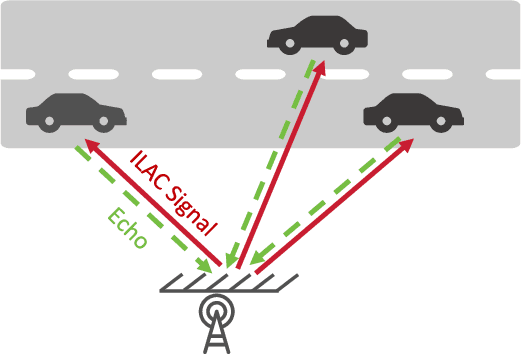
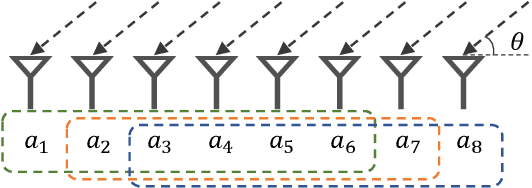
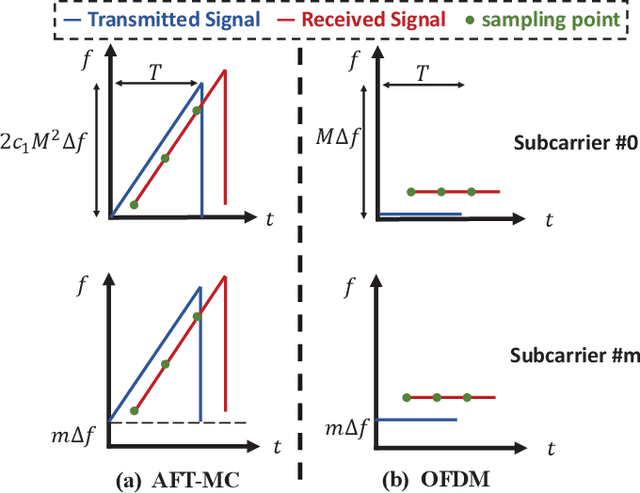
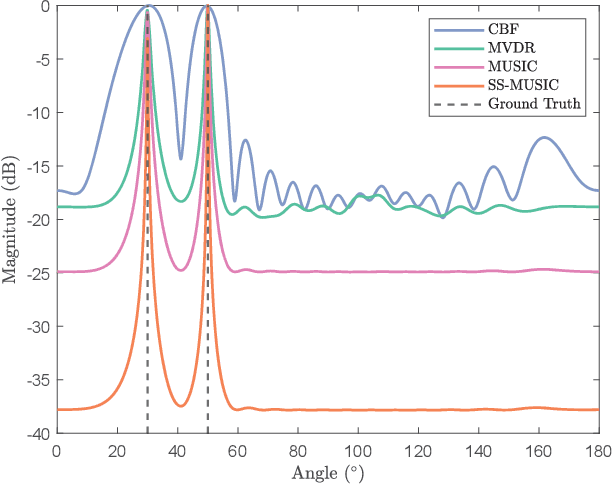
Abstract:This paper explores a novel integrated localization and communication (ILAC) system using the affine Fourier transform multicarrier (AFT-MC) waveform. Specifically, we consider a multiple-input multiple-output (MIMO) AFT-MC system with ILAC and derive a continuous delay and Doppler shift channel matrix model. Based on the derived signal model, we develop a two-step algorithm with low complexity for estimating channel parameters. Furthermore, we derive the Cram\'er-Rao lower bound (CRLB) of location estimation as the fundamental limit of localization. Finally, we provide some insights about the AFT-MC parameters by explaining the impact of the parameters on localization performance. Simulation results demonstrate that the AFT-MC waveform is able to provide significant localization performance improvement compared to orthogonal frequency division multiplexing (OFDM) while achieving the CRLB of location estimation.
Deep Reinforcement Learning-aided Transmission Design for Energy-efficient Link Optimization in Vehicular Communications
Apr 19, 2024



Abstract:This letter presents a deep reinforcement learning (DRL) approach for transmission design to optimize the energy efficiency in vehicle-to-vehicle (V2V) communication links. Considering the dynamic environment of vehicular communications, the optimization problem is non-convex and mathematically difficult to solve. Hence, we propose scenario identification-based double and Dueling deep Q-Network (SI-D3QN), a DRL algorithm integrating both double deep Q-Network and Dueling deep Q-Network, for the joint design of modulation and coding scheme (MCS) selection and power control. To be more specific, we employ SI techique to enhance link performance and assit the D3QN agent in refining its decision-making processes. The experiment results demonstrate that, across various optimization tasks, our proposed SI-D3QN agent outperforms the benchmark algorithms in terms of the valid actions and link performance metrics. Particularly, while ensuring significant improvement in energy efficiency, the agent facilitates a 29.6% enhancement in the link throughput under the same energy consumption.
GI-Free Pilot-Aided Channel Estimation for Affine Frequency Division Multiplexing Systems
Apr 01, 2024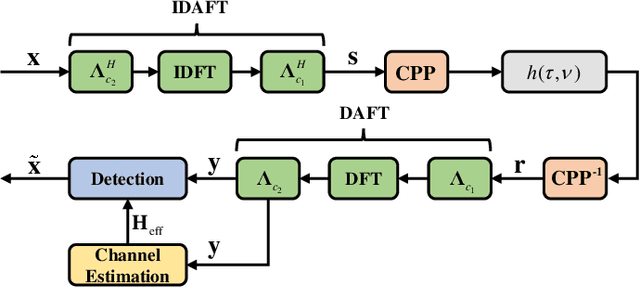

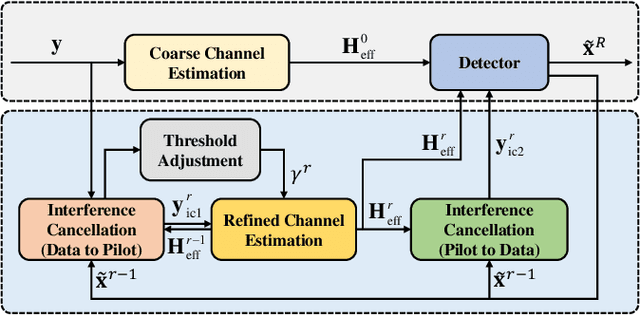
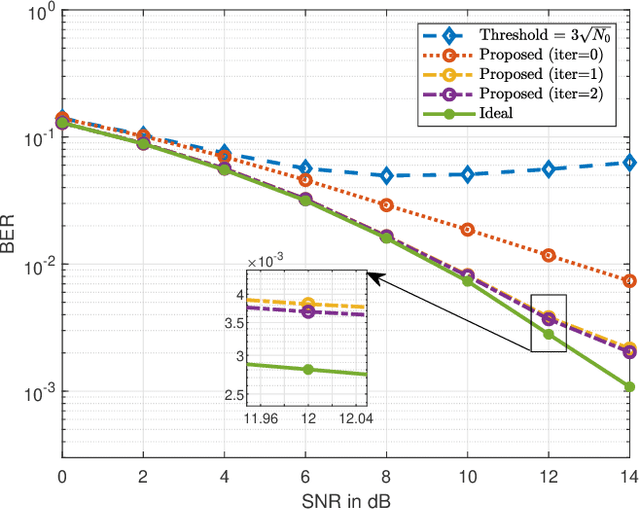
Abstract:The recently developed affine frequency division multiplexing (AFDM) can achieve full diversity in doubly selective channels, providing a comprehensive sparse representation of the delay-Doppler domain channel. Thus, accurate channel estimation is feasible by using just one pilot symbol. However, traditional AFDM channel estimation schemes necessitate the use of guard intervals (GI) to mitigate data-pilot interference, leading to spectral efficiency degradation. In this paper, we propose a GI-free pilot-aided channel estimation algorithm for AFDM systems, which improves spectral efficiency significantly. To mitigate the interference between the pilot and data symbols caused by the absence of GI, we perform joint interference cancellation, channel estimation, and signal detection iterately. Simulation results show that the bit error rate (BER) performance of the proposed method can approach the ideal case with perfect channel estimation.
A Low-Complexity Range Estimation with Adjusted Affine Frequency Division Multiplexing Waveform
Dec 29, 2023Abstract:Affine frequency division multiplexing (AFDM) is a recently proposed communication waveform for time-varying channel scenarios. As a chirp-based multicarrier modulation technique it can not only satisfy the needs of multiple scenarios in future mobile communication networks but also achieve good performance in radar sensing by adjusting the built-in parameters, making it a promising air interface waveform in integrated sensing and communication (ISAC) applications. In this paper, we investigate an AFDM-based radar system and analyze the radar ambiguity function of AFDM with different built-in parameters, based on which we find an AFDM waveform with the specific parameter c2 owns the near-optimal time-domain ambiguity function. Then a low-complexity algorithm based on matched filtering for high-resolution target range estimation is proposed for this specific AFDM waveform. Through simulation and analysis, the specific AFDM waveform has near-optimal range estimation performance with the proposed low-complexity algorithm while having the same bit error rate (BER) performance as orthogonal time frequency space (OTFS) using simple linear minimum mean square error (LMMSE) equalizer.
 Add to Chrome
Add to Chrome Add to Firefox
Add to Firefox Add to Edge
Add to Edge